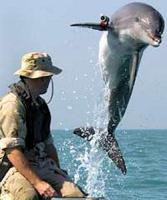 A bit over a week ago there were news reports with headlines that sounded like the plot of a low-budget sc-fi thriller. Huffington Post posted: “Ukrainian ‘Killer’ Dolphins Escape Naval Training Base In Search Of Love, Report Says.” Killer Dolphins Looking for Love! Terror with just the right mix of pathos. Great!
A bit over a week ago there were news reports with headlines that sounded like the plot of a low-budget sc-fi thriller. Huffington Post posted: “Ukrainian ‘Killer’ Dolphins Escape Naval Training Base In Search Of Love, Report Says.” Killer Dolphins Looking for Love! Terror with just the right mix of pathos. Great!
It turns out that it was a likely hoax. Dolphins trained by the Ukrainian military to detect mines and attack enemy swimmers, apparently did not escape after all. It is also likely that the title “killer dolphins” was a wild exaggeration was well. The US Navy has been using dolphins and other marine mammals since the 1950s, primarily to help in identifying underwater mines. The Russians also have been reported to have a dolphin training program but that it was shut down in 2000. Last year, it was reported that the Ukrainian navy has restarted special training for dolphins and other animals.
Update: Ukrainian Military Dolphins Not Actually on the Loose
While it has been reported that the Ukrainian dolphins are trained to attack enemy swimmers, the US Navy denies that their dolphins ever attack anyone. They say that the Navy dolphins locate swimmers but do not make any determination as to whether the swimmer is a friend or foe. That determination is left to US Navy divers. The Navy dolphins may be losing their jobs as mine spotters. By 2017, a mine-hunting robot is expected to relieve the dolphins of that duty.
From the Navy Marine Mammal Program website FAQ:
Does the Navy train its dolphins for offensive warfare, including attacks on ships and human swimmers or divers?
No. The Navy does not now train, nor has it ever trained, its marine mammals to harm or injure humans in any fashion or to carry weapons to destroy ships. A popular movie in 1973 (“The Day of the Dolphin”) and a number of charges and claims by animal rights organizations have resulted in theories and sometimes actual beliefs that Navy dolphins are assigned attack missions. This is absolutely false. Since dolphins cannot discern the difference between enemy and friendly vessels, or enemy and friendly divers and swimmers, it would not be wise to give that kind of decision authority to an animal. The animals are trained to detect, locate, and mark all mines or all swimmers in an area of interest or concern, and are not trained to distinguish between what we would refer to as good or bad. That decision is always left to humans.
Thanks to Alaric Bond for contributing to this post
